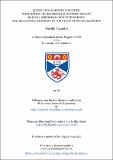Files in this item
Living and learning together : integrating developmental systems theory, radical embodied cognitive science, and relational thinking in the study of social learning
Item metadata
| dc.contributor.advisor | Laland, Kevin N. | |
| dc.contributor.author | Pagnotta, Murillo | |
| dc.coverage.spatial | viii, 251 p. | en_US |
| dc.date.accessioned | 2018-11-02T15:52:37Z | |
| dc.date.available | 2018-11-02T15:52:37Z | |
| dc.date.issued | 2018-12-06 | |
| dc.identifier.uri | https://hdl.handle.net/10023/16386 | |
| dc.description.abstract | Behavioural scientists argue that ‘social learning’ provides the link between biological phenomena and cultural phenomena because of its role in the ‘cultural transmission’ of knowledge among individuals within and across generations. However, leading authors within the social sciences have proposed alternative ways of thinking about social life not founded on the Modern oppositions including nature-culture, biology-culture, body-mind, and individual-society. Similarly, the distinction between a domain of nature and a domain of nurture has also been extensively criticized within biology. Finally, advocates of ‘radical embodied cognitive science’ offer an alternative to the representational-computational view of the mind which supports the conventional notion of culture and cultural information. This thesis attempts to integrate developmental systems theory, radical embodied cognitive science, and relational thinking, with the goal to bring the field of social learning closer to these critical theoretical developments. In Chapter 2, I find no justification for the claim that the genome carries information in the sense of specification of biological form. Chapter 3 presents a view of ontogeny as a historical, relational, constructive and contingent process. Chapter 4 uses the notions of environmental information, abilities, affordances, and intentions to make sense of behaviour and learning. In Chapter 5, I argue that the notion of social learning can be understood in terms of relational histories of development rather than in terms of transmission of information. I then report empirical studies investigating behavioural coordination and social learning consistent with this theoretical framework. Chapter 6 presents evidence that dyads in a joint making activity synchronize their attention constrained by their changing situation and that coordination of attention is predictive of implicit and explicit learning. Chapter 7 presents evidence that joint attention does not require gaze following and that attentional coordination is predictive of learning a manual task. Together, these theoretical and empirical studies suggest a new way of thinking about how humans and other animals live and learn socially, one that is consistent with critical theoretical and philosophical developments that are currently neglected in the literature on social learning. | en_US |
| dc.language.iso | en | en_US |
| dc.publisher | University of St Andrews | |
| dc.rights | Attribution-NonCommercial-NoDerivatives 4.0 International | * |
| dc.rights.uri | http://creativecommons.org/licenses/by-nc-nd/4.0/ | * |
| dc.subject | Social learning | en_US |
| dc.subject | Culture | en_US |
| dc.subject | Dynamical systems theory | en_US |
| dc.subject | Developmental systems theory | en_US |
| dc.subject | Ecological psychology | en_US |
| dc.subject | Enaction | en_US |
| dc.subject | Autopoiesis | en_US |
| dc.subject | Radical embodied cognitive science | en_US |
| dc.subject | Nature-nurture | en_US |
| dc.subject | Eye-tracking | en_US |
| dc.subject | Social life | en_US |
| dc.subject.lcc | HQ783.P2 | |
| dc.subject.lcsh | Social learning | en |
| dc.subject.lcsh | Culture | en |
| dc.subject.lcsh | Environmental psychology | en |
| dc.title | Living and learning together : integrating developmental systems theory, radical embodied cognitive science, and relational thinking in the study of social learning | en_US |
| dc.type | Thesis | en_US |
| dc.contributor.sponsor | Templeton Foundation | en_US |
| dc.contributor.sponsor | University of St Andrews. St Leonard's College | en_US |
| dc.type.qualificationlevel | Doctoral | en_US |
| dc.type.qualificationname | PhD Doctor of Philosophy | en_US |
| dc.publisher.institution | The University of St Andrews | en_US |
The following licence files are associated with this item:
This item appears in the following Collection(s)
Except where otherwise noted within the work, this item's licence for re-use is described as Attribution-NonCommercial-NoDerivatives 4.0 International
Items in the St Andrews Research Repository are protected by copyright, with all rights reserved, unless otherwise indicated.


